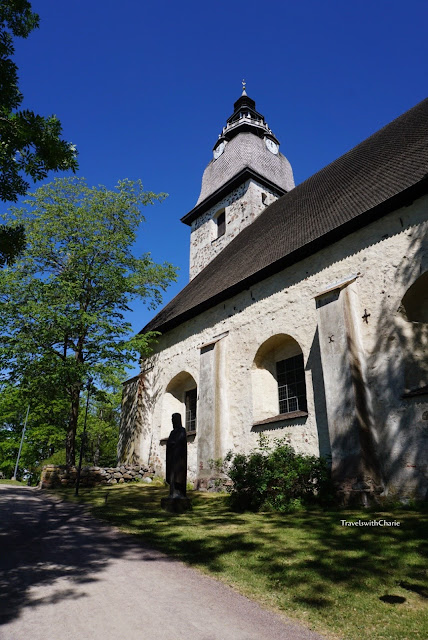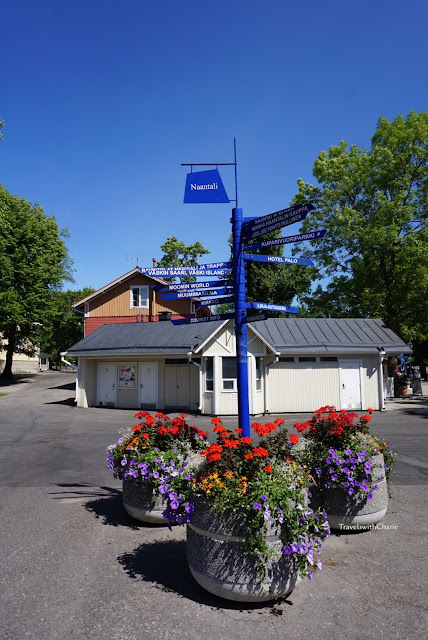The steeple of Naantali Church rises above the harbor and is the first thing you see on approach to the popular summer destination of Finland. It is the only remaining building from the convent of the Bridgittine Sisters built after the building permit was signed in 1443. The establishment of the Vallis Gratiae (Valley of Grace) convent coincides with the founding of Naantali. Both convent and town prospered from trading rights and privileges until the 1500s when Protestantism was introduced and adopted in Finland and the convent was closed. Naantali’s fortunes suffered with the closure and it was soon forgotten.
The discovery of therapeutic waters of Viluluoto Spring in Naantali in the 1700s helped the town get back on its feet with the initiation of spa activities. This was further developed in 1863 and established Naantali as a spa destination. Today, Moomin World Theme Park in Kailo draws the most visitors to Naantali. Children have the most fun meeting their favorite Moomin family characters from the famous books and comic strips written by Tove Jansson.
Naantali is easily accessible by steamboat from Turku. The s/s Ukkopekka leaves twice daily from the Aura River in Turku during the summer months through the pristine waters of the Airisto Sea. It's the perfect way to get some aquatic therapy and see some of the dreamy villas along the coast. Hungry? The ship’s restaurant offers a lunch buffet and light snacks.
Inside the restaurant and its well polished tables and bar. For more information about the s/s Ukkopekka, check here: https://www.ukkopekka.fi/en-gb/home
I took the bus back to Turku on my way home and got to see the small towns along the way. The bus trip between Turku and Naantali takes approximately 30 minutes. Catch the bus from Aurinkotie Street. For bus schedules, check here: https://www.foli.fi
The discovery of therapeutic waters of Viluluoto Spring in Naantali in the 1700s helped the town get back on its feet with the initiation of spa activities. This was further developed in 1863 and established Naantali as a spa destination. Today, Moomin World Theme Park in Kailo draws the most visitors to Naantali. Children have the most fun meeting their favorite Moomin family characters from the famous books and comic strips written by Tove Jansson.
I spotted several villas along the shore on the way to Naantali.
Inside the restaurant and its well polished tables and bar. For more information about the s/s Ukkopekka, check here: https://www.ukkopekka.fi/en-gb/home
I took the bus back to Turku on my way home and got to see the small towns along the way. The bus trip between Turku and Naantali takes approximately 30 minutes. Catch the bus from Aurinkotie Street. For bus schedules, check here: https://www.foli.fi
It is a beautiful walk from the harbor to the cluster of restaurants and shops along the marina. There are lots of restaurants overlooking the sea to choose from.
The medieval stone church of Naantali stands on a hill above the harbor. It’s one of the oldest monuments in Finland. The tower however, was not completed until 1797.
Naantali Church is also used for concerts and they were setting up the altar area when I was there. It helps to stop by the tourist office near the harbor to find out what’s on the calendar especially during the summer months when Naantali hosts a music festival in June and the Sleepyhead festival in July. The latter sounds intriguing.
Islands dot the seascape around Naantali.
There’s a reason for the Sleepyhead Festival. It almost seems as if everyone is taking a nap. Perhaps it was early summer and the kids were still in school preoccupied with their final exams. I feel so lucky when I don’t have to rub shoulders with hundreds of tourists.
It’s early afternoon as I stroll along one of the main streets in town to check out the boutiques and souvenir shops.
Typical houses with colorful paint line this street that juts from the harbor. Many houses have a name and this is inscribed on the front façade. The name of the pink house is Hattu. It means hat or tampion (plug of an organ pipe).
“The voice of the waves was now mixed with strange sounds; laughter, running feet and the changing of great bells far out to sea. Snufkin lay still and listened, dreaming and remembering his round world. Soon I must set out again, he thought. But not yet.” Tova Jansson, Finn Family Moomintroll
*This is a late post.
*****
Images by TravelswithCharie










